Blog
Vitiligo Demystified: From Myths to Miracles

Introduction:
Vitiligo is a skin condition that causes light-colored patches to appear on the skin. These patches develop when pigment-producing cells called melanocytes die or stop functioning. This results in a loss of melanin, the pigment that gives skin its color.
Vitiligo can affect any area of the body, but it’s most common on the hands, face, and neck. It can also affect the hair, lips, and inside of the mouth. The patches can be any size and shape, and they can spread or stay the same size.
Vitiligo is not contagious or life-threatening, but it can be emotionally and psychologically challenging. Some people with vitiligo experience self-consciousness or discrimination because of their condition.
Causes of vitiligo:
While the exact cause of vitilihttps://dev.derma.pk/?s=vitiligo&post_type=product&product_cat=0go remains elusive, researchers have identified several factors that potentially contribute to its development:
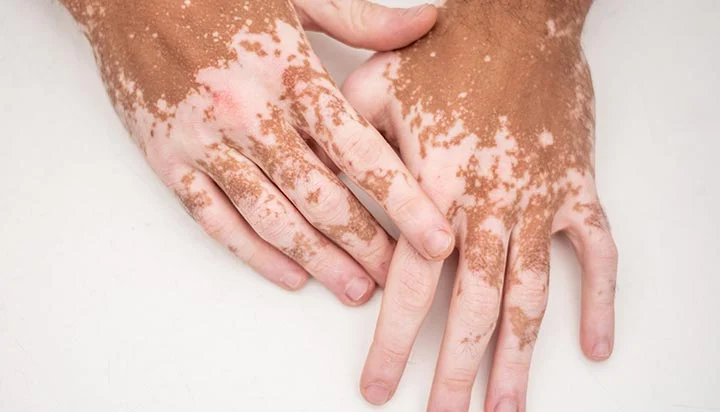
1. Autoimmune dysfunction: This is the most prominent theory, suggesting that vitiligo arises when the immune system mistakenly attacks and destroys melanocytes, the pigment-producing cells in your skin. This leads to decreased melanin production and the characteristic white patches.
2. Genetic predisposition: Studies suggest a strong genetic link to vitiligo. Around 30% of cases have a family history, indicating inheritance of genes that increase the susceptibility to developing the condition. These genes influence various aspects of melanocyte function and the immune system’s response.
3. Triggering events: Although not directly causing vitiligo, certain events can act as triggers, especially in individuals with genetic susceptibility. These include:
- Severe sunburn: Sunburn can damage melanocytes and initiate the autoimmune response.
- Skin trauma: Injuries like cuts, burns, or blisters can trigger vitiligo development at the affected site.
- Chemical exposure: Contact with certain chemicals like phenol can disrupt melanocyte function and lead to patch formation.
- Emotional stress: Severe or prolonged emotional stress may influence the immune system and potentially trigger vitiligo in some individuals.
4. Other potential factors: Research suggests additional factors may play a role in vitiligo, such as:
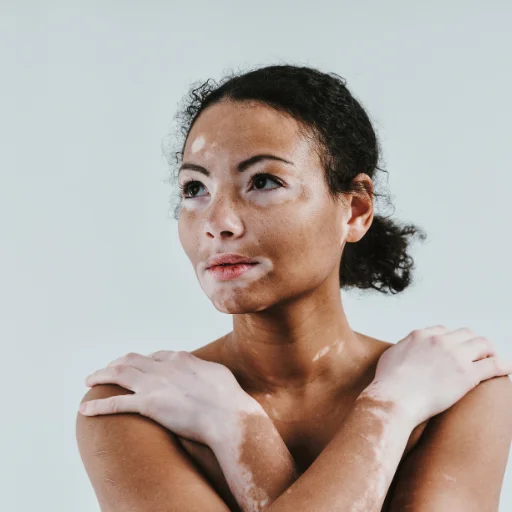
- Oxidative stress: An imbalance of free radicals and antioxidants in the body can damage melanocytes.
- Neurological factors: Abnormalities in the nervous system may disrupt communication with melanocytes, affecting their function.
- Vitamin deficiencies: Deficiencies in vitamin B12 or folic acid might be associated with an increased risk of vitiligo.
It’s important to note that the specific cause of vitiligo likely varies between individuals, and a combination of these factors may be involved in its development.
Symptoms of Vitiligo:
The main symptom of vitiligo is patchy loss of skin color, called depigmentation. These patches can appear anywhere on your body and typically exhibit the following characteristics:
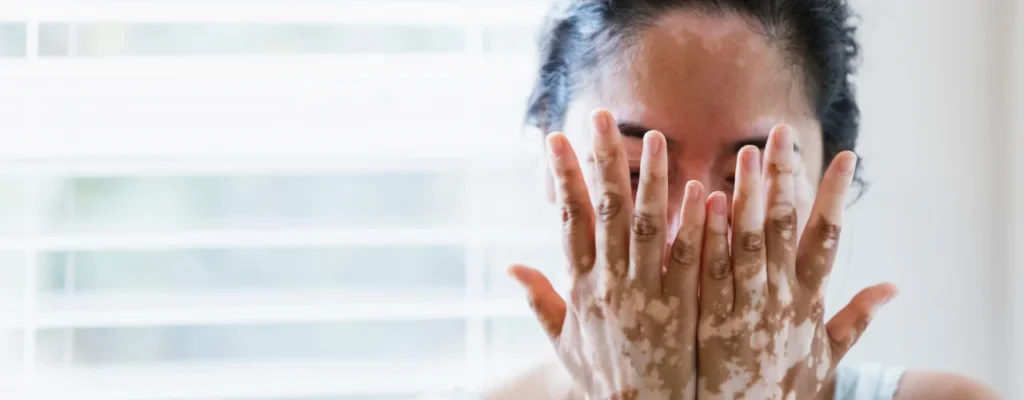
- Milky-white color: Often the most noticeable symptom, the affected patches lack melanin, giving them a distinctive lighter and milky-white appearance compared to the surrounding skin.
- Patch size and shape: The patches can vary greatly in size and shape, ranging from small dots to large areas covering significant portions of the body. Some patches may have irregular borders, while others might be more rounded.
- Location: While vitiligo can affect any area, it commonly appears on exposed areas like hands, face, lips, neck, forearms, feet, and elbows. It can also manifest on mucous membranes such as the inside of the mouth and genitals.
- Hair and eye changes: In some cases, vitiligo can affect hair pigmentation, causing premature graying or whitening of hair on the scalp, eyelashes, eyebrows, or other body hair. Loss of pigment in the iris can also occur, leading to lighter eye color or light spots on the eye.
- Border inflammation: Occasionally, the borders of the patches might be slightly inflamed or reddened, especially during the initial stages of development.
- Itching: Less frequently, some individuals with vitiligo might experience mild itching in the affected areas.
Important points to remember:
- The development of patches often occurs gradually, appearing as small, light-colored areas that progressively enlarge over time.
- While not contagious or life-threatening, vitiligo can affect individuals emotionally and psychologically due to its visible nature.
- The pattern of patch formation can vary between individuals, with some experiencing symmetrical patches on both sides of the body, while others may have patches scattered in different areas.
If you notice any of these symptoms, it’s crucial to consult a dermatologist for proper diagnosis and discuss available treatment options.
Stages of vitiligo:
Vitiligo, while not a progressive disease in the traditional sense, can manifest and develop over time in different ways. While there isn’t a universally agreed-upon staging system, understanding the potential progression patterns can help manage expectations and guide treatment decisions. Here are some general stages of vitiligo development, although it’s important to remember that individual experiences can vary:
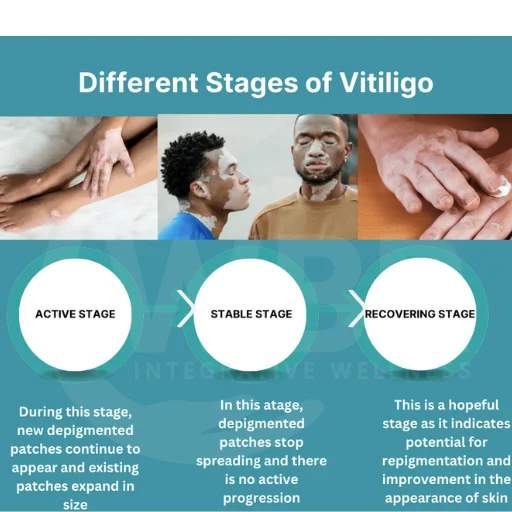
1. Early Stage:
- Initial patches: Vitiligo typically begins with small, isolated patches of lighter skin, often appearing on hands, face, or areas exposed to sun. These patches might be pinpoint-sized or slightly larger, with a well-defined border and a slightly reddish or inflamed edge in some cases.
2. Spreading Stage:
- Patch enlargement and merging: Over time, the initial patches can gradually enlarge, spreading across larger areas of the skin. They may also merge with other nearby patches, forming bigger depigmented areas.
3. Stabilization Stage:
- Patch stability: In some cases, vitiligo may reach a point where the patches stop expanding and remain relatively stable in size and appearance for extended periods. This is a common stage for many individuals.
4. Fluctuating Stage:
- Active and inactive phases: For some people, vitiligo can exhibit periods of active repigmentation, where the patches partially or fully regain color. These phases may alternate with periods of renewed activity where the patches enlarge or new patches appear.
5. Universal Vitiligo:
- Widespread depigmentation: In rare cases, vitiligo can affect a vast majority of the body’s skin, leading to a near complete loss of pigment. This is known as universal vitiligo and requires specialized management strategies.
Factors influencing progression:
- Individual variations: The rate and pattern of vitiligo progression can vary significantly between individuals. Age of onset, genetics, and underlying medical conditions can play a role.
- Triggering events: Certain events like sunburn, stress, or skin injuries can sometimes trigger new patch formation or accelerate existing vitiligo.
- Treatment interventions: Early diagnosis and appropriate treatment can help stabilize vitiligo and potentially promote repigmentation, influencing the overall progression.
Remember, these stages are not always clear-cut, and the course of vitiligo can be unpredictable. Consulting a dermatologist for regular monitoring and personalized treatment plans is crucial for managing the condition effectively
Myths regarding vitiligo:
Unfortunately, due to its visual nature, vitiligo has been surrounded by many myths and misconceptions over time. Here are some of the most common ones:
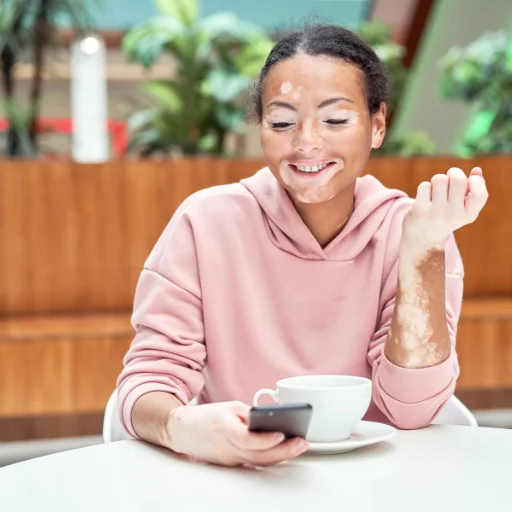
1: Vitiligo is contagious.
Fact: This is completely untrue. Vitiligo is not caused by any external factors like bacteria or viruses and cannot be transmitted from one person to another through touch or any other form of contact.
2: Only dark-skinned people get vitiligo.
Fact: While more noticeable on darker skin tones, vitiligo affects people of all skin tones and ethnicities equally. The lightened patches simply stand out more prominently against darker skin.
3: Vitiligo is related to other skin diseases like leprosy or albinism.
Fact: Vitiligo is a distinct condition from other skin diseases. Leprosy typically causes skin lesions and neurological damage, while albinism is a genetic disorder affecting melanin production throughout the body.
4: Certain foods or lifestyle choices cause vitiligo.
Fact: There is no scientific evidence linking specific foods or dietary habits to vitiligo development. Similarly, while stress may exacerbate existing symptoms, it is not a direct cause.
5: Vitiligo affects only physical appearance.
Fact: While not life-threatening, vitiligo can have a significant psychological impact on individuals. The social stigma and challenges in managing its appearance can lead to emotional distress and decreased self-esteem.
6: Vitiligo has no cure.
Fact: While there is no absolute cure for vitiligo, various treatment options can help manage its progression and improve repigmentation of the affected areas. These include topical creams, phototherapy, and surgical procedures.
7: People with vitiligo should avoid the sun.
Fact: While protecting your skin from harmful UV rays is essential for everyone, avoiding sunlight altogether can hinder repigmentation efforts in some cases. Consulting a dermatologist for proper sun protection and treatment guidance is crucial.
Remember, addressing these myths with accurate information is vital in raising awareness about vitiligo and dispelling the stigma surrounding it. If you encounter any of these misconceptions, be a voice of reason and share the facts to promote understanding and support for individuals living with vitiligo.
Treatment of vitiligo:

While there’s no definitive cure for vitiligo, several treatment options can help manage its progression and improve repigmentation. The choice of treatment depends on various factors like the extent of the affected area, disease activity, your skin type, and individual preferences. Here’s an overview of common treatment approaches:
1. Topical treatments:
- Corticosteroids: These creams or ointments suppress the immune system and can stimulate melanocyte activity, promoting repigmentation. They’re often used as initial therapy for smaller areas.
- Calcineurin inhibitors: These creams weaken the immune response and can be an alternative to corticosteroids, especially for sensitive areas like the face or genitals.
- Vitamin D analogues: Topical applications like calcipotriol can stimulate melanocyte activity and may be used alone or in combination with other treatments.
2. Phototherapy:
- Narrow-band UVB (NB-UVB) phototherapy: This involves controlled exposure to ultraviolet B light, which can stimulate melanocyte activity and repigmentation. It’s a common modality for widespread vitiligo and often delivered at home using special lightboxes.
- Excimer laser: This targeted laser therapy delivers concentrated UVB light directly to affected areas, making it suitable for smaller patches or areas resistant to other treatments.
https://blog.derma.pk/home-based-handheld-narrow-band-uvb-lamps-for-skin-diseases/
3. Other treatments:
- Depigmentation therapy: When widespread, and other treatments haven’t been effective, bleaching the remaining pigmented skin to match the white patches can be considered.
- Surgery: Skin grafting, where healthy skin is transplanted from unaffected areas to cover vitiligo patches, is typically used for small, stable areas and requires specialist evaluation.
- JAK inhibitors: Recently approved, topical ruxolitinib cream shows promise in repigmenting vitiligo patches. More research is ongoing on its long-term safety and efficacy.
Additional points to remember:
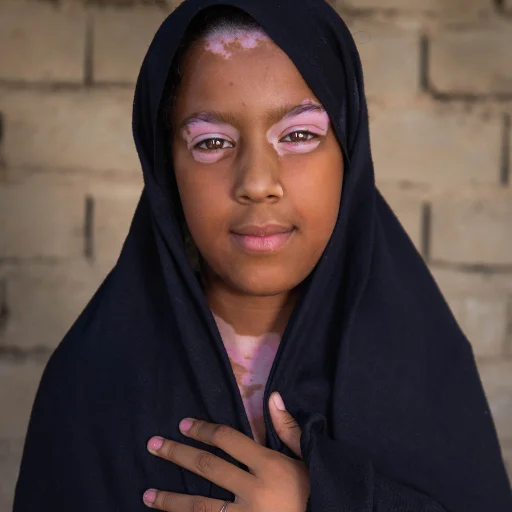
- Treatment success can vary. Some individuals experience significant repigmentation, while others may see limited improvement.
- Treatment typically requires prolonged use and regular follow-up with your dermatologist to monitor progress and adjust options as needed.
- Sun protection is crucial for everyone, particularly for individuals with vitiligo, as sun exposure can worsen the condition and increase the risk of sunburn.
- Addressing the emotional impact of vitiligo through counseling or support groups can be beneficial for managing the psychological challenges associated with the condition.
Remember, vitiligo management is a personalized journey. Consulting a dermatologist experienced in treating vitiligo is vital for establishing an individualized treatment plan and monitoring your progress. They can guide you through the available options and help you choose the most effective approach for your specific needs.
Final Thoughts:
Vitiligo, while not a life-threatening condition, can be challenging to manage due to its visible nature and potential psychological impact. However, understanding the causes, symptoms, and myths surrounding it empowers individuals and fosters empathy in society. Treatment options offer hope for managing its progression and improving repigmentation, with personalized approaches tailored to individual needs. Remember, sun protection and addressing the emotional aspects of vitiligo are crucial for overall well-being.
https://blog.derma.pk/?s=vitiligo
Derma and dental clinic:
Derma & Dental Clinic stands out with its team of experienced doctors backed by scientific evidence in their chosen fields. Their diverse range of medical-grade procedures offer tailored solutions for various skin and dental needs. You can confidently book your consultation online or by phone and embark on your journey towards healthier skin and a radiant smile.
Location: Bahria Town, Lahore
Specialties: Dermatology and Dental Care
Website: Derma.pk
For Consultation:
- Online at Dermatology.pk
- WhatsApp: +923205999650
- Phone: 03041115000
Categories
- Accessoreis
- Acne
- Aesthetic Procedures
- Anti Aging
- Author
- Baby Care
- Beauty
- Beauty & Cosmetics
- Blog
- Body Care
- cosmetic procedures
- Dandruff
- Dental Bonding
- Dental Care
- Dental Fillings
- Dental Health
- Dermatologist
- Dermatology
- Doctor
- Downloads
- Eye Care
- Food
- Food and Nutrition
- Hair Care
- Hair Loss Treatment
- Haircare
- Hand and foot care
- Health
- Health and Wellness
- Healthcare
- Imported Products
- Kids and baby care
- Laser Hair Removal
- Lip Care
- Medication
- Men's skin care
- Men's Skincare
- Nail Care
- Nutrition
- Oily Skin
- Online Consultation
- Oral Health
- Personal Care
- Pharmaceuticals
- Procedures
- Products and Ingredients
- scalp care
- Science
- Self care and wellness
- Shampoo
- Skin and Scalp Conditions
- Skin Care
- Skin Care and lifestyle
- Skin care myths and facts
- Skin Treatment
- Skincare
- skincare products
- Smile Design
- sunblocks
- Teeth Whitening
- wellness
- Whitening and brightening














